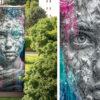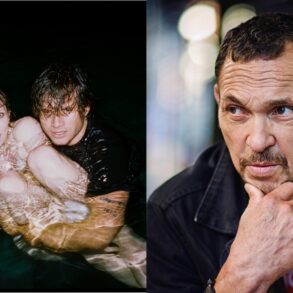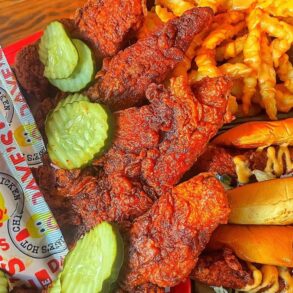This is the fourth post in our fourth season of Philly Street Art Interviews! This season is sponsored by Philadelphia International Airport (PHL) and its @PHLAirportArt program, which curates museum-quality art exhibitions that introduce millions of visitors from around the world to the vibrant artistic culture of the region. PHL proudly supports Philly arts and culture/365! Interview and photos by Streets Dept Lead Contributor Eric Dale.
By my reckoning, bolt-ups are one of the least-used mediums in street art. Generally speaking, a bolt-up is an artwork created at-home or in-studio, usually on a piece of wood or particle board, and then attached to an existing street sign’s pole using standard bolts and nuts. The back of the bolt is often hammered until it bends down, preventing the piece from being easily removed by unscrewing the nut.
A fair number of sticker artists in Philly dabble in bolt-ups, but few artists make them a main focus of their work. The notable exception is D.T., a street artist who defies categorization—seemingly by design—and has been quietly creating innovative, beautiful, and just plain cool art since about 2008. It’s often on blocks of wood mounted to sign posts.
The first place I remember seeing a D.T. installation was on the old construction wall at 5th and Bainbridge. In a way, that hideous, drab wall created the perfect backdrop to augment D.T.’s fantastic color palette and masterful composition. But it already stood out for what it was: abstract street art—a rarity.
Going against the grain by creating abstract pieces with unusual materials and an experimental attitude is embedded in D.T.’s art practice. Let’s find out where it’s led him.
Street Dept’s Eric Dale: What was the first piece of street art that you ever installed?
DT: I think the very first things I did were these little—they were probably about 3 inch by 3 inch—wood tiles. And I really didn’t install them; I made them, and then I would go put them out on, like, payphones and ledges, and then I would walk down a little bit and just watch if somebody took it or not. Because they would have little notes that said if you found this, visit my MySpace.
SD: Wow, so old!
DT: Yeah, and a couple people did that. I had one guy that found a piece and then was like I’m going to Texas, and I’ll just leave it out there somewhere.
SD: What year was that?
DT: It had to have been like ‘07 or ‘08. Yeah, something like that.
SD: So what inspired you to create those pieces and start putting them out like that?
DT: Seeing stuff that El Toro was doing. Nose, Under Water Pirates’ stuff. I was just like I can draw on stuff; I want to do this. That’s what it was.
SD: The OGs! How has your work changed over time?
DT: Oh man, I don’t know. It’s gone from doing, like, cyclops characters I used to draw… I don’t know, man. I don’t know how to explain it. ‘Cause I constantly change what I do. It’s gotten better; it’s gotten bigger… I want to do bigger stuff now, because I see people like Doomed Future and YOMI… So, yeah, I want to start doing something bigger, because I’m usually known for doing smaller things. Or I’ll make smaller pieces but make one big piece out of [them]—I’ve done that a few times. But now I got a big roll of paper so I want to just do big things now.
And be more loose, too. I do that line work stuff, but now it kind of feels like I’m known for that, and I kind of want to change it now. ‘Cause I like my backgrounds more than I like them black lines. So that’s why I did that one at the Target. I didn’t want to do the lines in that one; I just wanted to do a big quote-unquote background. So I’m moving towards that; I just want to do more freestyle, abstract, nonsense stuff, whatever. There’s no plan in any of that stuff!
SD: Okay! So when we planned this interview, you had a very specific place in mind to install a bolt-up. From a lay perspective, it would seem like you could just put one of those anywhere. So how did you choose this particular location?
DT: I wanted to reclaim it, because I’d been there before. I knew the one over at Yards was messed up, but not as messed up as it is now. It’s evolved way more now—I love it! I love how it’s just a chunk of dirty wood with a bolt through it now. But yeah, I wanted to reclaim that spot.
SD: I see! So I know you have a tenuous relationship with social media. Can you tell me about that?
DT: I don’t know, I just love it. Because as a kid, in school, we would have penpals, and I’ve always liked mail, and writing letters to people, and receiving things in the mail from people. And social media is just like that, where you can have a straight-up conversation with somebody. I talk to people from, like, New Zealand! And people all over the country—you can just talk to people and show people things and you can react to what people are [doing]. I don’t know. I guess I’m addicted to it. I love it too much—I always say oh I’m gonna quit, I’m gonna quit, but I always come right back.
SD: Well I was going to ask you about a particular Instagram Story you posted earlier this year—
DT: Heh heh heh yup.
SD: In it, you wrote, among other things, “I don’t live in my computer. I’m a real person. A real artist. My work is better appreciated in real life.” So, what prompted that screed?
DT: Oh man, that was just me seeing—alright, you know how social media can be, like, poisonous to the mind? It was starting to get to me, and I just kept seeing what other people were doing, and it seemed like they were just doing it… better than me? And there’s a lot of—I hate to be critical about art—but there’s a lot of bad stuff out there, that’s just not good, that gets way too much attention. And I just feel like I was wasting my time and working too hard, and it was getting pointless because I wasn’t creating shit and that’s why nobody likes what I do. I was starting to feel like that.
SD: In that post, you also announced that you were retiring your “camera bird thing”—can you speak to that?
DT: Yes, I’m not going to do that anymore—
SD: So explain the stickers you were just putting up!
DT: I still have them. And in celebration of retiring them, Phil E. Twist wanted to do a collaboration with me.
SD: Specifically because you said that?
DT: Yes. So I said we’ll do a collab or whatever. And he threw me a couple of ideas, and it was probably within a few hours or whatever I had something and sent it to him, and he was like yeah! And then I printed them.
But my thing about that is I’m not going to be using that anymore because it’s something you see on the security stickers on doors, on stores, and shit like that. All I did was put straight bird legs on it. So everything that I produce from now on, I want it to be my original work—100% everything original. No more Donald Duck, no more Mickey Mouse shit. You know what I mean? The only thing that I will probably still do every once in a while is I will take, like, a kids show character and then put, like, a metal band logo behind them, just because every once in a while I like going on the computer; just messing with shit like that. I’m not good at it, but I like messing around and just making weird stuff like that. I’ll do that, but I’m not trying to make anything from it. I’m not even trying to get any kind of cred for that or whatever. I just do that for fun. I crack up at them.
SD: You also use various fish in your artworks a lot. What are the fish about?
DT: I love fish. The way I draw fish is because I can’t draw realistically. So I was like I want to draw a fish, but I can’t make him look real, so I might as well just make him look weird.
SD: Your fish look great!
DT: Yeah, that’s what everyone says, so I guess it’s working because it’s original. Like, if you saw that, you would go oh I know who did that. Because nobody else does it like that, and I’ve worked, purposely, years to try to get that. For a while, I just had that one fish that I would do. It was easy to draw real quick, I could do it on stickers; I could just do it on anything I wanted. But it wasn’t good enough, so I just kept trying to make more and more fish. And then I seen that technique where people print, like, real fish. I forget what it’s called. I was just like I wonder if I could make something that looked like that. That’s where the silhouette, like, the ones that are solid black [came from]. It was kind of that concept. And then the last fish that I did were just straight drawings. They’re not colored in. But I did some different designs on their backs that I used to do; just circles and ovals on there. Try to make them look weird, but like fish at the same time.
SD: Most of your work these days is abstract. What significance does this style hold for you?
DT: Cause it’s easier to be abstract than it is to try to be realistic. Sometimes I think why paint something so realistic, that already exists, when you could just take a picture of that and look at it. If you’re gonna paint something, paint something that doesn’t exist; that is weird-looking. [I don’t understand people who] probably paid a lot of money and worked real hard to get this skill—to just paint things that are real, when you can just look at that thing. What’s the point of painting that? Now, if you take that scene and you do something abstract to it, I like that, because you looked at it and you were like alright, what if I did this to it? If I chopped it up and put it here, that’s cool. But the photorealism paintings, I don’t know, man, I just don’t get it.
And I can’t do that. I was never taught that. I don’t know anything about color theory. I don’t even know what the definition of that is. I was never taught any of that stuff. I use whatever colors I want. Sometimes you learn—hey, you put orange over this yellow? Oh, it turns brown. That’s gross. And you don’t do it again. Or you do it, cause you’re just like fuck it. I got a brown streak in this now. It’s just so much easier to try to make something that’s yours. I give people more respect for that, for having their own style. ‘Cause it took me a few years to get to where I’m at now. It’s the one thing that I worked at—and to make my stuff clean. My stuff, most of the time, has to be clean. I kind of want to step away from that, too. But even my sloppy stuff, everyone’s like dude, that’s so clean. It’s so clean. But I got that from hanging out at TMoms with all the character dudes. They were always saying oh, that’s clean, that’s clean. I was like I gotta clean my shit up!
SD: Haha! So other than sticker artists, what’s been the biggest influence on your aesthetic?
DT: Jeez, I don’t know. Sometimes people will point things out and be like oh man, that looks like so 80s, or that looks so 90s or whatever. When I hear people say that, I go okay, well I guess I’m doing something right, so I’ll just stick with that. But I don’t know. I feel like everything I do is just accidental. I don’t really try to keep an aesthetic, you know what I mean? Just, ‘cause, like, my stuff changes all time, so I can’t really stick to one specific aesthetic.
SD: Would you say that maybe natural selection is a big influence on your aesthetic, almost?
DT: I don’t know, what do you mean?
SD: Like, you’re just experimenting, and so it’s like you’re mutating your artwork, and finding oh, this kind of works, so I’ll continue to evolve this…
DT: Oh, ok, yeah, yeah! I do do that. When I learn how to do [something interesting], when accidentally something happens, I will [then] do it on purpose. And then you do it on purpose a couple of times and it gets refined. I’ve done that several times, especially in my line work, because it started with just straight lines. And then one day I made one with a bunch of straight lines and a couple of curved lines in it. And I was like well what if I just put more curved lines in? And then it was like well what would happen if some of the lines were thick and then some of them were thin? And then one day I accidentally did a piece with lines and I like made them look like stairs. And somebody was like that’s like some Escher shit. And I was like nice! So then I started purposely doing it. And I don’t think a whole lot of people noticed it, but yeah, if people say certain things, I will take that part and I’ll keep doing that.
SD: Well hopefully this interview influences you to continue painting things that I like! Speaking of which, another exciting element of your work is the incorporation of found objects, like bicycle gears and machine parts. Where do you find stuff like this, and why do you use it in your art?
DT: Sometimes if I see a bike in the trash in my neighborhood, I’ll take it just to take the gears off of it to make pieces with it. One of the first times I ever did that was because I would walk to work from my house to Toys “R” Us, and it was in the parking lot of Franklin Mills Mall. In parking lots, there’s always just shit laying around, so I would just keep finding, like, metal… things. And then I found this skateboard in the trash. It was broken. So I took that skateboard, and I took all the pieces I gathered up, and I wired them up to the skateboard. Like, I drilled little holes for the wires and just wired all these objects that I found. But yeah, that started the object thing. And then I love bikes—that’s where the gear thing comes from. I’ve been riding for 41 years now. No car, no license.
SD: How do you think you’re different from other Philly street artists?
DT: I just do totally different things. I try to be different. That’s why I would do, like, 150 four inch by six inch pieces, and then just staple them. Everybody’s wheatpasting. Everybody’s got stickers. Nobody uses staples—right?
SD: Nope!
DT: That’s where that came from. I’ve actually gone away from that now because people that I go out with and put stuff [up with] don’t like how it’s loud. It draws attention, and if I do a piece that consists of a hundred [smaller] pieces, that’s, you know, two hundred staples!
Because my girlfriend works in the hair replacement industry, she turned me on to this men’s grooming tape. It’s like one inch by three inches and all it is is super strong double-sided tape. And I started using them on the paint swatch [pieces] on the channeled [sign] poles. It’s perfect for that. I just started cutting them in half and putting them on the back of smaller pieces. It’s quieter; it’s quicker. I also try to use a different kind of paper than everybody uses. I hand-make everything. I know some people that I like, they go big, but their stuff is definitely coming outta Kinko’s. They make it on the computer and then they just have it printed out. That’s their thing or whatever, but they also have the skill that they could be making them themselves, and I just don’t know why they don’t do that—like a large screenprint. This is a skill that these people have!
Look at how I do stuff—when I do them little pieces, I’m not printing one big sheet of that shit and cutting them out—I’ll do 150 prints. Sometimes there’s three or four colors! So it’s possible, it’s very possible. I try to push people to do that all the time. I really do. I appreciate it more if somebody does it handmade—like Gloopy Goblin, his handmade stuff. It’s just [the influence of] the people that I was being around. Everything was about hand-drawn stickers.
SD: Right, that used to be such a big thing.
DT: Yeah, and it’s definitely not a thing anymore. I don’t have a character, but my stickers are still handmade. I feel like there’s a lot of people that don’t hand-draw anymore. It looks like it’s starting to come back—there’s a group of people that are still doing it. But I feel like me printing stickers is basically the same as hand-drawing a sticker because I still made it myself. I made the design, I used my materials to do everything. I didn’t make the vinyl; I didn’t make the ink or the screens, but I made those stickers. If people want to know how to make vinyl stickers, they can hit me up; I will show them how to do it. I was always told you gotta let other people know how to do stuff. If they knew how easy it was, we’d have way more of them. Way more.
SD: This is a great call to arms! I love it. Ok, this is potentially a tough question—both to hear and to answer—but I genuinely want to know what you think. Your work is striking, unique, and beautiful, and it’s clear from the process videos you regularly share on Instagram and what we’ve just been talking about that you really care about your craft. And we’ve talked about the benefits and the detriments of social media, but nevertheless, it tends to be a decent measure of general appreciation. And you have under 1000 followers(!)—which has led me to call you the “most underrated street artist in Philly.” So my question is… why the hell aren’t you more popular?!
DT: I don’t know. It’s a good question. It really is. It drives me crazy, because I see some of these people that [have] like 15 thousand [followers] and all they’re doing is just not-so-great stuff. I really don’t know. I always think that it’s because I don’t know how to market myself. Do you ever see me using any trending audio? Never. I never do that. Because when you go through the Stories or the Reels, it starts to become the same thing. Like ooh, I get to finally shoot a video of me turning around and showing a painting of… I hate those things. I don’t do those. I don’t do the trending content that people are making.
I think that’s what it is. I don’t trend. You can see the music that I choose for my videos is not normal. It’s never normal. Ever. I’m not on that part of the algorithm that everyone’s seeing because they’re all doing the same thing. It seems to just feed you the same thing. This is what’s popular. This is what’s popular. I’m just not. I’ve never been a popular person. I don’t want to be just another one of those people. I’m about originality—I really am. Strongly. To the point it can be annoying. I have been told that I do go a little too far with it; that I will not like something because it’s not original.
SD: Have you ever thought about painting a mural? Or a public mural, sorry.
DT: I’ve done one, and I guess it was semi-public? Because it was a place that was open to the public, but it had business hours—it was the Philadelphia Insectarium and Butterfly Pavilion.
SD: That’s why I changed the wording of this question to say “public mural,” ‘cause I saw that piece in their bathroom and it was awesome!
DT: Like in real life you saw it?
SD: Yeah! I walked into that bathroom and I was like no way. They have a huge DT mural here. I can’t believe it. This is awesome.
DT: Really! No way. Yeah, I got that gig from Frank [Chapelle].
SD: So, public murals: is that something you’re interested in?
DT: Yes. Yes, very much. But I’ve never done anything bigger than that bathroom. And I don’t know how to do that because I’m so used to just using markers.
SD: You know what’s great about Philly? You just ask someone, and they’ll tell you. Just like you were saying ask me how to make your own vinyl stickers. People will tell you!
DT: Yeah! But yeah, dude, I would love to do a nice-sized mural.
SD: Well that’s about it, so thanks so much for doing this interview!
DT: No problem, dude.
This post was originally published on this site be sure to check out more of their content.









